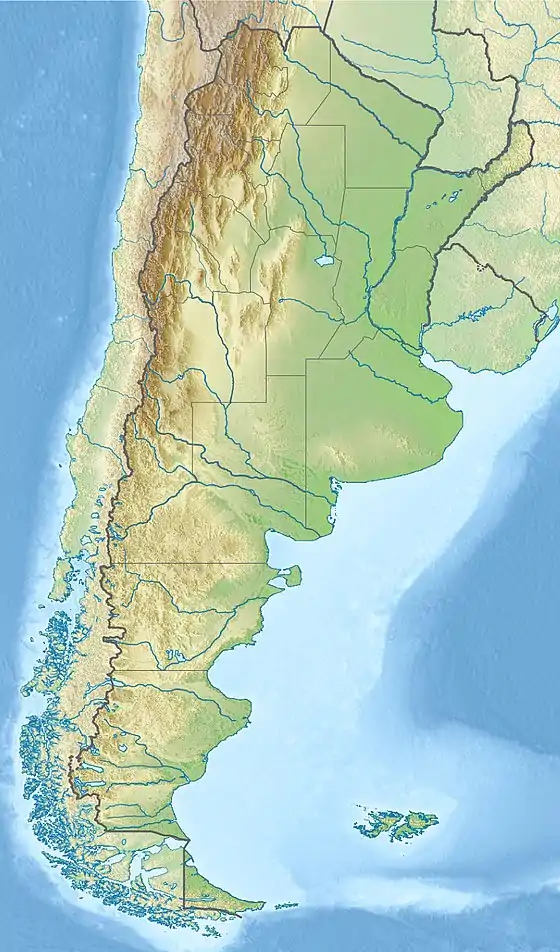 Ruins in the Plaza Pedro del Castillo in the city of Mendoza after the 1861 earthquake. | |
 | |
| UTC time | 1861-03-20 |
|---|---|
| Local date | March 20, 1861 |
| Local time | 11:30 PM |
| Magnitude | 7.2 Ms |
| Depth | 30 km (19miles) |
| Epicenter | 32°32′S 68°32′W / 32.54°S 68.54°W[1] |
| Fault | Cal Fault[2] |
| Type | Thrust fault[2] |
| Areas affected | Argentina, Mendoza Province |
| Max. intensity | IX (Violent) |
| Landslides | yes |
| Casualties | 6,000–12,000[3] |
The 1861 Mendoza earthquake occurred in the province of Mendoza, Argentina on 20 March at 11:30 PM. It had an estimated magnitude of 7.2 on the Ms scale and an intensity of IX–X on the Mercalli scale. Its hypocenter was located at an estimated depth of 30 kilometres (19 mi).
Tectonic setting
The city of Mendoza lies just to the east of the Precordillera structural belt, at the eastern margin of the Andes mountain belt. The ongoing flat slab subduction of the Nazca Plate below the South American Plate is causing shortening in the over-riding plate that is concentrated in the Precordillera belt, with a rate of 4.5±1.7 mm per year, from GPS data. This shortening is expressed as active thrust faulting. The two active thrust faults near Mendoza are the Peñas Thrust and the Cal Thrust, with the latter reaching the surface inside the city. This zone is one of the most seismically active parts of the Andes.[2]
Earthquake
The earthquake is thought to have been caused by rupture of the Cal Thrust. The estimated magnitude of 7.2 Ms is consistent with the estimated slip rate and frequency of ruptures along this fault, which suggest vertical offsets in the range 0.8–1.0 m for the last three to four earthquakes.[2]
Damage
The earthquake devastated the provincial capital, Mendoza, killing somewhere in the range of 6,000 to 12,000 people,[4][3] although even higher numbers have been suggested, with thousands more being injured.[5] Most of the buildings were destroyed, including the cabildo (colonial government house). Fires caused by rupturing of the gas supply for lighting in some stores lasted for four days. The obstruction of canals led to local flooding.[3] The effects of liquefaction were widely reported and many large landslides were observed.[6]
The town was rebuilt in a nearby location, and the authorities moved to their new seat in 1863. The new constructions, which incorporated modern architectural styles, were markedly different from the old colonial buildings.
Notable deaths
See also
References
- ↑ Ceresis. "Consulta al Catálogo de Hipocentros (1520–1981) (search page)" (in Spanish). Archived from the original on 20 July 2011. Retrieved 1 March 2011.
- 1 2 3 4 Schmidt, S.; Hetzel, R.; Mingorance, F.; Ramos, V.A. (2011). "Coseismic displacements and Holocene slip rates for two active thrust faults at the mountain front of the Andean Precordillera (~33°S)". Tectonics. 30 (5). Bibcode:2011Tecto..30.5011S. doi:10.1029/2011TC002932.
- 1 2 3 Moreiras, S.M.; Páez, M.S. (2015). "Historical damage and earthquake environmental effects related to shallow intraplate seismicity of central western Argentina". In Sepúlveda, S.A.; Giambiagi, L.B.; Moreiras, S.M.; Pinto, L.; Tunik, M.; Hoke, G.D.; Farías, M. (eds.). Geodynamic Processes in the Andes of Central Chile and Argentina. Special Publication. Vol. 399. Geological Society, London. doi:10.1144/SP399.6. ISBN 9781862396531. S2CID 128901206.
- ↑ "Historical earthquakes". www.inpres.gov.ar. Archived from the original on 29 September 2011. Retrieved 13 January 2022.
- ↑ National Geophysical Data Center / World Data Service (NGDC/WDS): NCEI/WDS Global Significant Earthquake Database. NOAA National Centers for Environmental Information. (1972). "Significant Earthquake Information". NOAA National Centers for Environmental Information. doi:10.7289/V5TD9V7K. Retrieved 2022-03-23.
- ↑ Perucca, L.P.; Moreiras, S.M. (2006). "Liquefaction phenomena associated with historical earthquakes in San Juan and Mendoza Provinces, Argentina". Quaternary International. 158 (1): 96–109. Bibcode:2006QuInt.158...96P. doi:10.1016/j.quaint.2006.05.023.
- (in Spanish) Epicentro de los terremotos destructivos en Argentina (1692–2012) Listado de Terremotos Históricos.
Further reading
- Dauer, Quinn P. (2012). Natural Disasters and Comparative State-Formation and Nation-Building: Earthquakes in Argentina and Chile (1822–1939) (PhD). Florida International University. doi:10.25148/etd.FI12120403 – via FIU Electronic Theses and Dissertations.